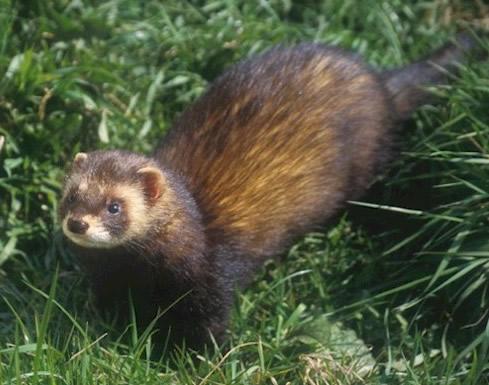Name: European Polecat (Mustela putorius)
Scientific classification:
Kingdom: Animalia
Phylum: Chordata
Class: Mammalia
Order: Camivora
Family: Muselidae
Genus: Mustela
Species: Mustela putorius
Evolution:
The earliest true polecat was Mustela stromeri, which appeared during the late Villafranchian. It was considerably smaller than the present form, thus indicating that polecats evolved at a relatively late period. The oldest modern polecat fossils occur in Germany, Britain and France, and date back to the Middle Pleistocene. The European polecat's closest relative is the steppe polecat, with which it is thought to have shared Mustela stromeri as a common ancestor. It is however not as specialised as the latter species, being more infantile in skull structure.
Build:
The general appearance of the European polecat is typical of members of the genus Mustela, though it is generally more compact in conformation and, although short-legged, is not as elongated in body as the mink or steppe polecat. The tail is short, about ⅓ its body length. The eyes are small, with dark brown irises. The hind toes are long and partially webbed, with weakly curved, 4 mm non-retractable claws. The front claws are strongly curved, partially retractable and measure 6 mm. The polecat's skull is relatively coarse and massive, moreso than the mink's, with a strong, but short and broad facial region and strongly developed projections. In comparison to other similarly sized mustelids, the polecat's teeth are very strong, large and massive in relation to skull size. Sexual dimorphism in the skull is apparent in the lighter, narrower skull of the female, with weaker projections. The polecat's running is not as complex and twisting that that of the mink or stoat, and it is not as fast as the solongoi, stoat or least weasel, as it can be outrun by a conditioned man.
The dimensions of the European polecat vary greatly. Males measure 350-460 mm in body length and females 290-394 mm. The tail measures 115-167 mm in males and 84-150 mm. Adult males in middle Europe weigh 1,000-1,500 grams and females 650-815 grams. Gigantism is known among polecats, but specimens exhibiting this are likely the products of polecat-mink hybridization.
Diet:
The European polecat's main source of food consists of mouse-like rodents, followed by amphibians and birds. Its most frequent prey item in the former Soviet Union is the common vole and rarely red-backed voles. In large river floodlands, water vole are commonly preyed upon. In winter, amphibians (especially grass frogs and green toads) become an important food item. However, because these species have little calorific value, the polecat never grows fat on them, no matter how many they consume. Bird species preyed upon by the European polecat include chickens, pigeons, quails, grey partridges, grouses and various small birds. Some rarer species preyed upon by the polecat include European hedgehogs, asp vipers, grass snakes and insects. There is one record of a polecat attacking a European mink and dragging it to its burrow.
The European polecat hunts its prey by stalking it and seizing it with the canine teeth, killing the animal with a bite to the neck. This killing method is instinctive, but perfected with practice. It commonly kills brown rats and European rabbits, and is capable of killing larger prey such as geese and hares. The polecat sometimes caches its food, particularly during seasonal gluts of frogs and toads. Sometimes, the polecat does not kill these, but bites them at the base of the skull, thus paralyzing them and keeping them fresh.
Behaviour:
Unlike the steppe polecat, the European polecat has a much more settled way of life with definite home ranges. The characteristics of polecat home ranges vary according to season, habitat, sex and social status. Breeding females settle in discreet areas, whereas breeding males and dispersing juveniles have more fluid ranges, being more mobile. It is typical for males to have larger territories than females. Each polecat uses several den sites distributed throughtout its territory. Occasionally, abandoned European badger or red fox burrows are used. Rabbit warrens are often areas of intense polecat activity. In winter, the polecat may use farm buildings or haystacks as daytime resting sites. The polecat is not as territorial as other small mustelids, having been known to share territories with other members of the same sex. There is little evidence of polecats marking their territories.
Reproduction:
The European polecat is a seasonal breeder, with no courtship rituals. During the mating season, the male grabs the female by the neck and drags her about in order to stimulate ovulation, then copulates for up to an hour. The species is polygamous, with each male polecat mating with several females. Unlike with other small mustelids, there is no induced ovulation. The gestation period lasts 40-43 days, with litters usually being born in May-early June. Each litter typically consists of 5-10 kits. At birth, the kits weigh 9-10 grams and measure 55-70 mm in body length, and are blind and deaf. At the age of one week, the kits are covered in silky, white fur, which is replaced with a cinnamon brown-greyish woolly coat at the age of 3-4 weeks. Weaning begins at 3 weeks of age, while the permanent dentition erupts after 7-8 weeks. The kits become independent after 2-3 months.
Vulnerability:
Not endangered, hunted.
For use:
The European polecat is a valuable fur bearer, whose pelt is more valuable than the steppe polecat's. Its skin is used primarily in the production of jackets, capes and coats. It is particularly well suited for trimmings for women's clothing. The tail is sometimes used for the making of paintbrushes. Prior to the First World War, the Russian Empire produced more than 50% of global polecat skins. The harvesting of polecats in Russia increased substantially after the October Revolution, coinciding with a decline in polecat numbers in western Europe. The Russian population of polecats decreased somewhat after the Second World War, and their hunting was discouraged, as polecats were acknowledged to limit harmful rodent populations
